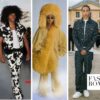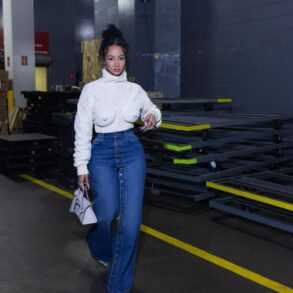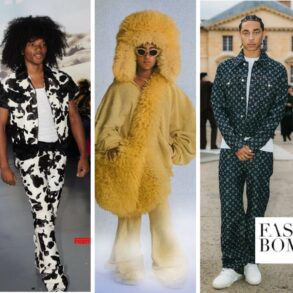
Taken from the new print issue of THE FACE. Get your copy here.
On a bog-standard morning in South London, it’s pissing it down. But inside photographer Sunil Gupta’s flat-cum-studio in Camberwell, among the embroidered rugs, pillowy sofas and prints of queer Indian men mounted on the walls, the sweet sound of twinkly ’70s Bollywood blasting out of a speaker banishes the autumnal Monday gloom. This is a space of warming familiarity. It’s tinged with domestic nostalgia that has a brown British twentysomething like me recalling being young, overfed by aunties and feeling a little, well, different.
In the far corner of the studio, visual artist duo Athen Kardashian and Nina Mhach Durban – the latter, coincidentally, wrote her university dissertation on Gupta’s subversive ’70s/’80s work documenting sexuality, race and migration during the UK and US’s politically turbulent decades – are describing their practice to his partner and collaborator Charan Singh, also a photographer. “We use collage, found objects, Bollywood… lots of Bollywood!” says Durban, one half of a duo whose work layers those aesthetic influences with pop culture ephemera on cork boards and whiteboards, like an eclectic scrapbook exploring themes of youth, the home and teen bedrooms.
Over on the sofa, Sheena Patel, author of 2022’s incandescent anti-romance novel I’m a Fan, is flicking through Gupta’s most recent photobook, Come Out, 1985 – 1995, which covers a decade of London’s queer liberation protests.
On the other side of the room Rish Shah, whose breakout role was in Disney+ series Ms. Marvel, is scanning the crammed bookshelves before he moves on to looking at the trinkets Gupta, 70, has amassed over his years spent in India, New York and London. These fill most of the room. “I’m sure you know where everything is, though!” says the London-born actor, admiring the organised chaos.
Today, Gupta is shooting 13 of the finest emerging talents of British South Asian descent: across art, fashion, literature, theatre, football, film and music. As well as Kardashian and Mhach Durban, Patel and Shah, we’re joined by fashion designer Harri KS, who creates blown-up latex craftwork; artist Jake Grewal, who paints mythical nudes inspired by the ambiguity of his queer experiences; and musician, and London nightlife regular, Mya Mehmi.
There’s playwright Mohamed-Zain Dada, whose dreamlike debut Blue Mist, which premiered to acclaim at London’s Royal Court, examines masculinity through the perspective of young British Muslim men (brought to life by the stellar cast of Salman Akhtar, Omar Bynon and Arian Ni, also present). We have Hamza Choudhury, the tenacious defensive midfielder who recently signed a new deal at Leicester City.
And finally, there’s Namita Khade, a womenswear designer from Wigan whose knitted garments, mostly pieced together, are inspired as much by the smart clothing of her relatives in grainy photographs as they are by the thrill and freedom of being young and going out-out.
Of course, there have been peaks of brown-and-British representation in the UK before, most notably during the UK’s embrace of multiculturalism in the late-1990s and early-’00s. Meera Syal’s 1996 book Anita and Me depicted the challenges of being a confused young brown girl in ’70s Staffordshire, while Sheffield boxer Prince Naseem Hamed was a prominent figure beyond sport throughout the ’90s, beloved for his eccentric entrances and cocky persona as much as he was his fists of fury.
On screen, between 1998 and 2001, Syal starred in BBC comedy Goodness Gracious Me, which parodied stereotypes to side-splitting effect, poking fun at the collision of Indian and British culture. East is East, originally a 1996 play by Ayub Khan-Din at the Birmingham Repertory Theatre, was a box-office hit when, in 1999, FilmFour turned it into an accurate portrayal of a British-Pakistani mixed-ethnicity household in ’70s Salford (Chris Bisson, who played Saleem Khan in the film, would join Coronation Street as part of its first Asian family that year).
This post was originally published on this site be sure to check out more of their content.








